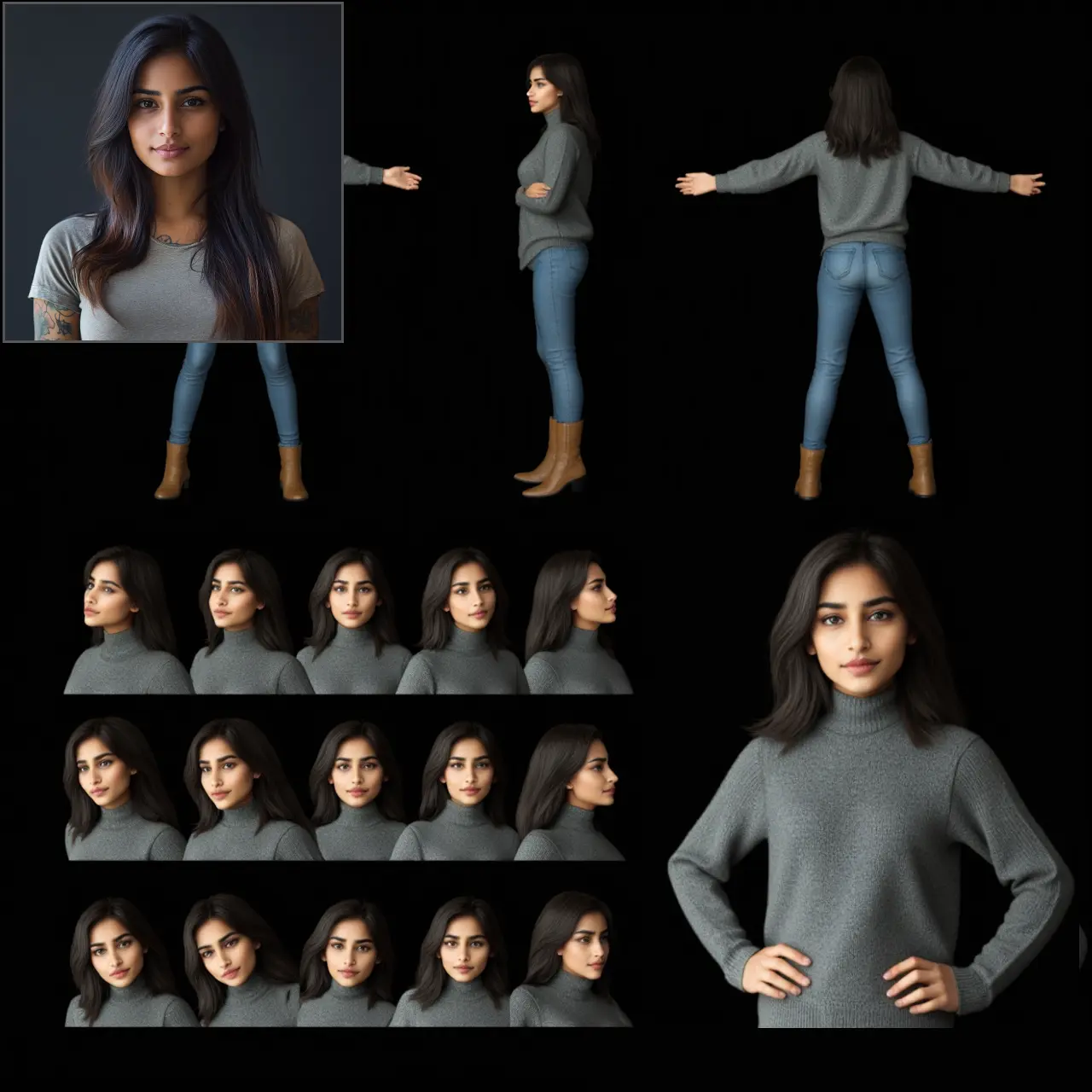ComfyUI Node: Latent Diffusion Mega Modifier
Latent Diffusion Mega Modifier
CategoryclybNodes
Clybius (Account age: 2018days) Extension
ComfyUI-Latent-Modifiers Latest Updated
2024-06-14 Github Stars
0.08K
How to Install ComfyUI-Latent-Modifiers
Install this extension via the ComfyUI Manager by searching for ComfyUI-Latent-Modifiers- 1. Click the Manager button in the main menu
- 2. Select Custom Nodes Manager button
- 3. Enter ComfyUI-Latent-Modifiers in the search bar
Visit ComfyUI Online for ready-to-use ComfyUI environment
- Free trial available
- 16GB VRAM to 80GB VRAM GPU machines
- 400+ preloaded models/nodes
- Freedom to upload custom models/nodes
- 200+ ready-to-run workflows
- 100% private workspace with up to 200GB storage
- Dedicated Support
Latent Diffusion Mega Modifier Description
Enhance latent representations in diffusion models with advanced modification techniques for AI-generated art.
Latent Diffusion Mega Modifier:
The Latent Diffusion Mega Modifier is a powerful node designed to enhance and manipulate latent representations in diffusion models. This node provides a suite of advanced techniques to modify the latent space, allowing for fine-tuned control over the generated outputs. By leveraging methods such as contrast adjustment, dynamic thresholding, and various noise manipulation techniques, the Latent Diffusion Mega Modifier enables you to achieve higher quality and more diverse results in your AI-generated art. The primary goal of this node is to offer a comprehensive set of tools to refine and optimize the latent space, ensuring that the final output aligns closely with your artistic vision.
Latent Diffusion Mega Modifier Input Parameters:
sharpness_multiplier
This parameter controls the intensity of the sharpness applied to the latent representation. A higher value increases the sharpness, making the details more pronounced, while a lower value results in a softer image. The default value is typically set to 1.0, with a minimum of 0.1 and a maximum of 10.0.
sharpness_method
This parameter specifies the method used for sharpening the latent representation. Different methods can produce varying effects on the final output, allowing you to choose the one that best suits your artistic needs. Common methods include "unsharp_mask" and "laplacian".
tonemap_multiplier
This parameter adjusts the intensity of the tonemapping applied to the latent representation. Tonemapping helps in managing the dynamic range of the image, ensuring that details are preserved in both the highlights and shadows. The default value is 1.0, with a minimum of 0.1 and a maximum of 10.0.
tonemap_method
This parameter defines the method used for tonemapping. Different methods can affect the image's contrast and color balance in unique ways. Examples include "reinhard" and "gated".
tonemap_percentile
This parameter sets the percentile value used in the tonemapping process. It helps in determining the threshold for dynamic range compression, affecting how highlights and shadows are handled. The default value is 50, with a minimum of 0 and a maximum of 100.
contrast_multiplier
This parameter controls the level of contrast applied to the latent representation. Increasing the contrast multiplier enhances the difference between light and dark areas, making the image more vivid. The default value is 1.0, with a minimum of 0.1 and a maximum of 10.0.
combat_method
This parameter specifies the method used to combat configuration drift in the latent space. Different methods can stabilize the latent representation in various ways, such as "subtract", "subtract_channels", "subtract_median", and "sharpen".
combat_cfg_drift
This parameter adjusts the intensity of the combat configuration drift method. A higher value increases the effect, helping to stabilize the latent representation more aggressively. The default value is 0.0, with a minimum of -1.0 and a maximum of 1.0.
rescale_cfg_phi
This parameter controls the rescaling factor for the configuration phi. It helps in adjusting the overall scale of the latent representation, ensuring that it remains within a desirable range. The default value is 1.0, with a minimum of 0.1 and a maximum of 10.0.
extra_noise_type
This parameter specifies the type of extra noise to be added to the latent representation. Different noise types can introduce unique variations and textures to the final output. Examples include "gaussian" and "perlin".
extra_noise_method
This parameter defines the method used for adding extra noise. Different methods can affect the distribution and intensity of the noise in various ways, such as "additive" and "multiplicative".
extra_noise_multiplier
This parameter controls the intensity of the extra noise added to the latent representation. A higher value increases the noise level, introducing more variation and texture. The default value is 1.0, with a minimum of 0.1 and a maximum of 10.0.
extra_noise_lowpass
This parameter sets the lowpass filter value for the extra noise. It helps in smoothing out high-frequency components of the noise, resulting in a more coherent texture. The default value is 0.0, with a minimum of 0.0 and a maximum of 1.0.
divisive_norm_size
This parameter specifies the size of the divisive normalization applied to the latent representation. Divisive normalization helps in balancing the intensity of different regions, ensuring a more uniform appearance. The default value is 1, with a minimum of 1 and a maximum of 10.
divisive_norm_multiplier
This parameter controls the intensity of the divisive normalization. A higher value increases the effect, making the latent representation more uniform. The default value is 1.0, with a minimum of 0.1 and a maximum of 10.0.
spectral_mod_mode
This parameter specifies the mode used for spectral modulation. Different modes can affect the frequency components of the latent representation in unique ways, such as "lowpass" and "highpass".
spectral_mod_percentile
This parameter sets the percentile value used in the spectral modulation process. It helps in determining the threshold for frequency component modification, affecting how different frequencies are handled. The default value is 50, with a minimum of 0 and a maximum of 100.
spectral_mod_multiplier
This parameter controls the intensity of the spectral modulation. A higher value increases the effect, modifying the frequency components more aggressively. The default value is 1.0, with a minimum of 0.1 and a maximum of 10.0.
affect_uncond
This parameter specifies whether the modifications should also affect the unconditional latent representation. Setting this to true ensures that both conditional and unconditional latents are modified, providing a more consistent output. The default value is false.
dyn_cfg_augmentation
This parameter controls the dynamic configuration augmentation. It helps in adjusting the latent representation dynamically based on the current configuration, ensuring optimal results. The default value is 1.0, with a minimum of 0.1 and a maximum of 10.0.
seed
This parameter sets the random seed for reproducibility. Providing a specific seed value ensures that the same modifications are applied consistently across different runs. The default value is None.
Latent Diffusion Mega Modifier Output Parameters:
modified_latent
The modified latent representation is the primary output of the node. It contains the enhanced and manipulated latent space, ready for further processing or direct use in generating the final image. This output is crucial as it encapsulates all the adjustments made based on the input parameters, ensuring that the generated art aligns with your desired modifications.
Latent Diffusion Mega Modifier Usage Tips:
- Experiment with different sharpness and tonemap methods to find the combination that best suits your artistic style.
- Use the contrast multiplier to enhance the vividness of your images, but be cautious of over-contrasting, which can lead to loss of detail.
- Adjust the combat_cfg_drift parameter to stabilize the latent representation, especially when working with complex or high-variance inputs.
- Utilize the extra_noise_type and extra_noise_method parameters to introduce unique textures and variations to your images.
- Leverage the seed parameter for reproducibility, ensuring consistent results across different runs.
Latent Diffusion Mega Modifier Common Errors and Solutions:
"Invalid sharpness_multiplier value"
- Explanation: The sharpness_multiplier value provided is outside the acceptable range.
- Solution: Ensure that the sharpness_multiplier value is between 0.1 and 10.0.
"Unsupported tonemap_method"
- Explanation: The specified tonemap_method is not recognized.
- Solution: Verify that the tonemap_method is one of the supported methods, such as "reinhard" or "gated".
"combat_cfg_drift out of range"
- Explanation: The combat_cfg_drift value is outside the acceptable range.
- Solution: Ensure that the combat_cfg_drift value is between -1.0 and 1.0.
"Invalid extra_noise_type"
- Explanation: The specified extra_noise_type is not recognized.
- Solution: Verify that the extra_noise_type is one of the supported types, such as "gaussian" or "perlin".
"Invalid seed value"
- Explanation: The seed value provided is not valid.
- Solution: Ensure that the seed value is an integer or None for random seed generation.
Latent Diffusion Mega Modifier Related Nodes
RunComfy is the premier ComfyUI platform, offering ComfyUI online environment and services, along with ComfyUI workflows featuring stunning visuals. RunComfy also provides AI Models, enabling artists to harness the latest AI tools to create incredible art.


